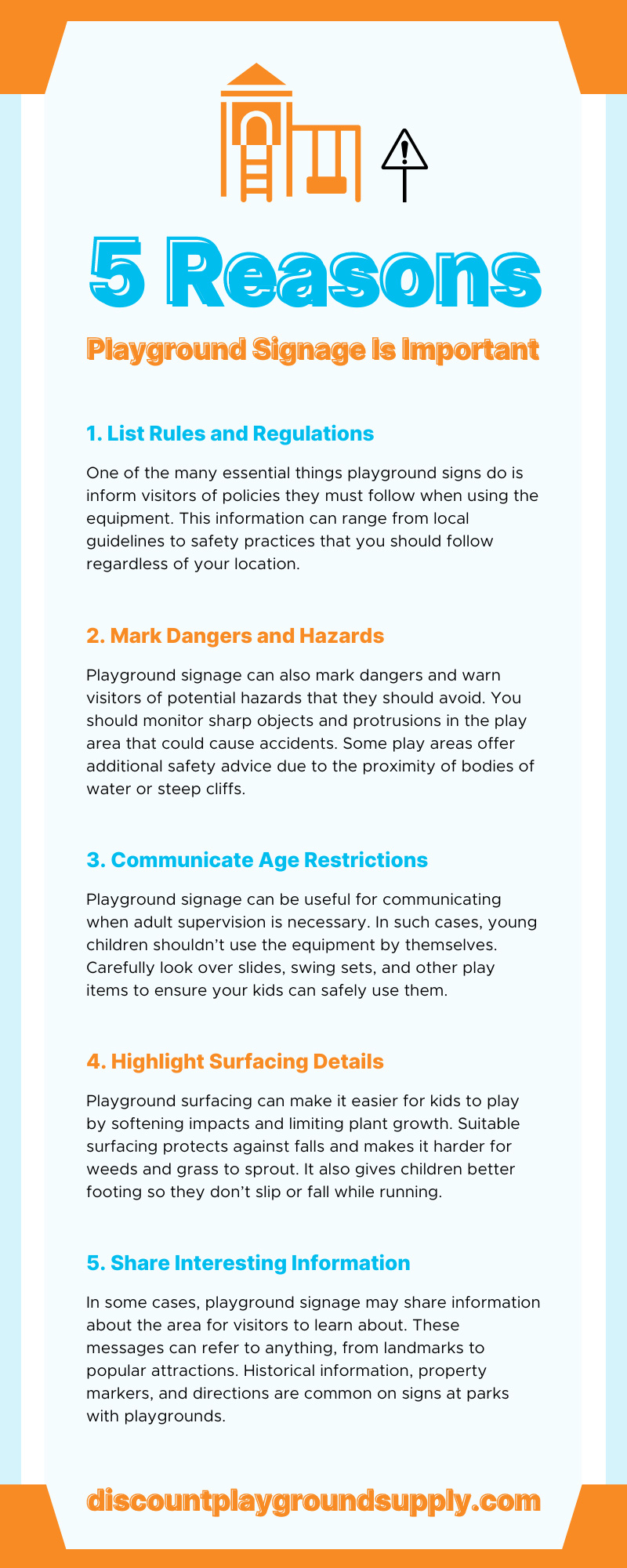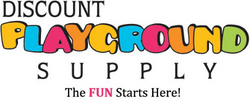Taking your kids to the playground gives them the opportunity to develop their strength, agility, and coordination while having fun. They get the chance to socialize with other kids and learn how to interact with the world around them. However, parents should pay close attention to any information posted in the vicinity to ensure the safety of their children.
Warning signs and instructions are there to protect you and your kids from harm and maintain the quality of the equipment. Failing to read signs or ignoring their content may result in accidents or even law-breaking. Understanding what playscape signage is conveying will allow you to make better decisions while out with your children. Here are five reasons playground signage is important.
What Is Playground Signage?
You may find important warnings and messages posted in various locations on the playground. Whether it’s a plaque, flyer, or signpost, you should always be wary of the information they provide. In many cases, signs display essential rules, mark hazards, and communicate weather conditions that visitors should watch out for.
Never ignore playscape signage, especially if you’re new to the area. When you arrive at a playground, look for any notices that could convey critical details you need to know. If signs are broken or illegible, you can contact the local park department to get an idea of their meaning.
1. List Rules and Regulations
One of the many essential things playground signs do is inform visitors of policies they must follow when using the equipment. This information can range from local guidelines to safety practices that you should follow regardless of your location. Being mindful of their surroundings and correctly using equipment will ensure your kids stay safe and don’t hurt themselves or damage anything.
Rules can dictate many things, from where kids can run freely to using slides, swings, and steps properly. Signage can also inform you about broken equipment to avoid until further notice. Height or weight restrictions may also be posted around the play area. Watching your kids and ensuring they follow the rules will ensure everyone has fun while playing.
2. Mark Dangers and Hazards
Playground signage can also mark dangers and warn visitors of potential hazards that they should avoid. You should monitor sharp objects and protrusions in the play area that could cause accidents. Some play areas offer additional safety advice due to the proximity of bodies of water or steep cliffs.
Other hazards, such as pits, slopes, and sudden drops, will likely be marked by signage. Good risk management involves looking over the area carefully for posted information that can keep your kids safe. However, the park managers may not notice everything. Learning to identify hazards yourself will ensure you don’t miss anything that wasn’t marked by a sign.
3. Communicate Age Restrictions
Playground signage can be useful for communicating when adult supervision is necessary. In such cases, young children shouldn’t use the equipment by themselves. Carefully look over slides, swing sets, and other play items to ensure your kids can safely use them. Signs can mark age-appropriate equipment so parents don’t have to guess what is and isn’t safe for their kids.
Advocates of child safety understand the importance of age restrictions for playscape equipment. Ensuring kids are ready to use it will allow them to get age-appropriate exercise and stay safe while enjoying the outdoors. Parents should be cautious of their children playing on places that are high off the ground, made of hard materials, or easy to get caught in, like bars or netting.
4. Highlight Surfacing Details
Playground surfacing can make it easier for kids to play by softening impacts and limiting plant growth. Suitable surfacing protects against falls and makes it harder for weeds and grass to sprout. It also gives children better footing so they don’t slip or fall while running. Whether it has loose fill or unitary surfacing, it can make a massive difference in the safety of a play area.
Common materials include artificial turf, concrete, mulch, sand, and gravel. However, most modern play areas employ rubber. Signs at playgrounds may provide details about surfacing and how it works. Encourage your children to stay off play equipment that gets hot on sunny days, such as metals and hard plastics, to ensure your kids don’t get burned. Wet or slippery surfaces may also be posted as a hazard to watch out for.
5. Share Interesting Information
In some cases, playground signage may share information about the area for visitors to learn about. These messages can refer to anything, from landmarks to popular attractions. Historical information, property markers, and directions are common on signs at parks with playgrounds. You might see postings for events such as concerts, festivals, and sales occurring in the area.
In rare instances, someone may decide to upgrade their equipment or change locations and offer a good deal on their used play items. A sale posting should include a picture of the item, its condition, and who to contact if you want to make an offer. If you’re interested in purchasing commercial play equipment but not finding any in your area, you can often get what you’re looking for online. Be sure to check reviews, pricing, and whether there’s a manufacturer warranty so you get the best deal possible.
Get All the Information You Need Before Letting Your Kids Play
A day at the playground can be fun, but things can turn bad quickly if you don’t pay close attention to signage. Important rules, common dangers, and details about safe play can ensure your children don’t get injured while playing. They’re also crucial for communicating key details about the area you may be interested in learning.
Reading signage at the playscape will give you all the information you need to avoid potential hazards. Playground signage is important for many reasons, and the safety of you and your children should be your top priority. After you’ve checked the area for crucial details and safety notices, you can allow your kids to play.


